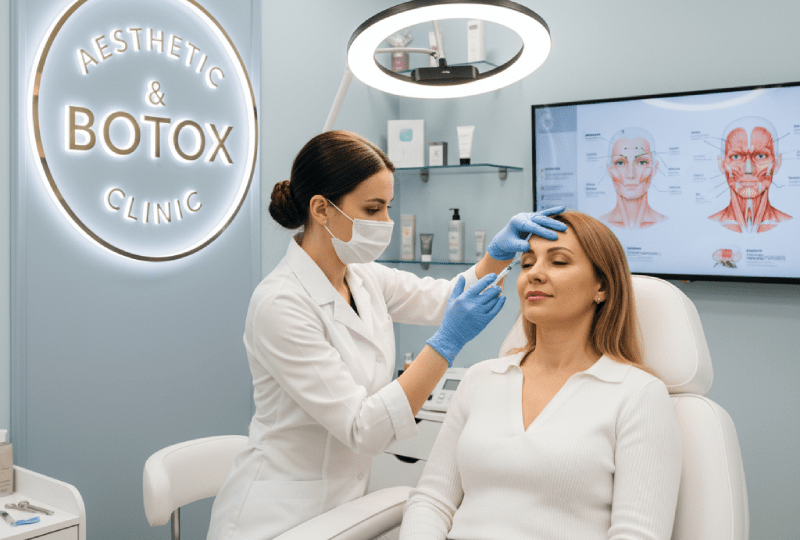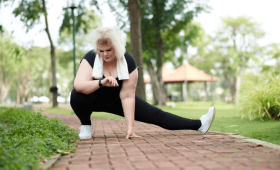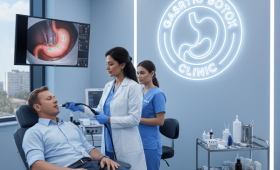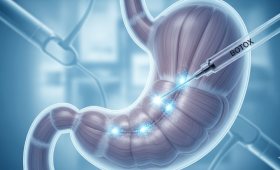What Is Stomach Botox And How Does It Work?
Stomach Botox is a non-surgical, endoscopic procedure applied to support the weight loss process. During the procedure, Botulinum toxin (Botox) is injected into specific muscle areas of the stomach wall. This toxin temporarily reduces the contractile strength of the stomach muscles, which prolongs the stomach emptying time.
The extended emptying time means food remains in the stomach for a longer duration. Consequently, the patient experiences a feeling of fullness for a longer time, which naturally results in less food consumption. Stomach Botox is an effective supportive treatment method that makes it easier for patients to adhere to a healthy diet program.
Why Are Kusadasi Stomach Botox Prices Advantageous?
Kusadasi, as one of the popular centers for health tourism in the Aegean Region, offers international standards of service for procedures like stomach Botox, while providing much more economical prices compared to Western European countries. The primary reasons for this price advantage include low general operating costs, lower personnel expenses, and exchange rate differences in Turkey. Clinics often use high-quality, internationally accepted Botox brands but can offer the procedure and additional services like accommodation in cost-effective packages. This situation ensures that patients can protect their budget without compromising the quality of the treatment.
Who Is A Suitable Candidate For Stomach Botox?
Stomach Botox is generally suitable for individuals who do not require surgical methods (like sleeve gastrectomy) but struggle to lose weight through diet and exercise alone. Candidates are typically expected to have a Body Mass Index (BMI) between 27 and 35. Patients with stomach conditions like ulcers or gastritis must have these issues treated before the procedure. Ideal candidates are individuals who are not allergic to Botox or the anesthetic drugs used, have chronic diseases under control, and possess the motivation to adhere to the nutritional program after the operation.
Is Stomach Botox A Surgery And Is Anesthesia Necessary?
Stomach Botox is not a surgical procedure and does not require any incision, stitches, or scarring. It is an endoscopic procedure, meaning a thin, flexible tube (endoscope) with a camera at its tip is guided into the stomach through the mouth. To ensure patient comfort and prevent any discomfort during the procedure, it is typically performed under light sedation (a conscious twilight state). Thanks to sedation, the patient is in a state of deep relaxation throughout the procedure, feels no pain, and does not remember the operation. This method ensures the accurate and precise application of Botox while maximizing patient safety and comfort.
How Long Does The Procedure Take And Is Hospitalization Required?
The stomach Botox procedure, excluding the preparation stages and the time taken for sedation to take effect, the injection part of the Botox takes about 15 to 20 minutes, a short duration. After the procedure, the patient is rested in an observation room for about 1 to 2 hours until the effect of the sedation completely wears off and for control purposes. Stomach Botox does not require hospitalization because it is not a surgical operation. The patient can return home or to their accommodation accompanied by a companion once the observation period is over. This quick process offers a major time advantage for international patients coming to Kusadasi.
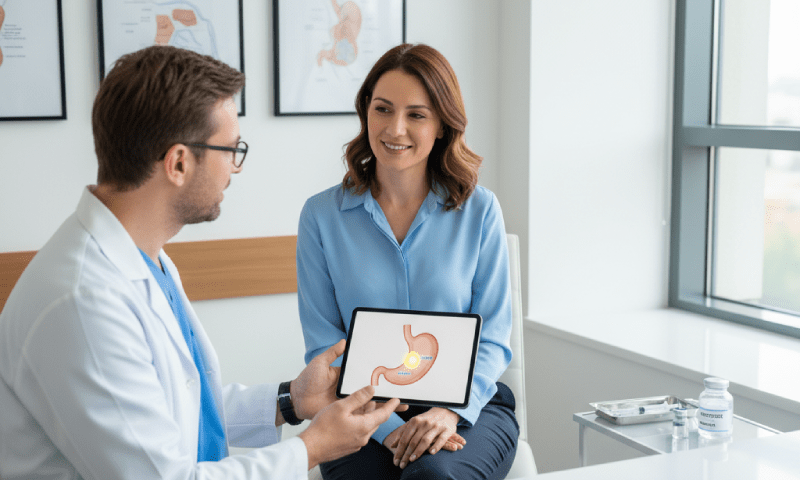
When Does The Effect Of Stomach Botox Treatment Begin?
The effects of stomach Botox treatment regarding creating a feeling of fullness and controlling appetite do not appear immediately after the procedure but generally begin to emerge gradually within the first 3 to 7 days. The full effect of Botox and the significant slowing of the stomach’s emptying time typically reach their maximum level within a period of two weeks. It is vital for patients to strictly adhere to the provided nutrition and diet program during this initial period, rather than immediately expecting results, as this will enhance the effect of the Botox and accelerate the weight loss process.
How Long Does The Effect Of Stomach Botox Last?
The effect of stomach Botox, which reduces the contractile strength of the stomach muscles to induce satiety and suppress appetite, usually continues for 4 to 6 months. Since the effect of Botulinum toxin on nerve endings is temporary, it is completely metabolized by the body during this period, and muscle functions slowly begin to return to normal. For the patient not to regain weight after the Botox effect wears off, it is crucial that the healthy eating habits acquired during the procedure have become permanent. The duration of the effect may vary slightly depending on the brand of Botox used and the patient’s metabolic rate.
How Should The Diet Be After The Procedure?
After the stomach Botox procedure, a special diet is mandatory to maximize the effect of the Botox and avoid irritating the stomach. Only liquid foods (water, clear soup, fruit juice) should be consumed for the first 24 hours. Pureed and soft foods are gradually introduced during the first week. Fatty, acidic, carbonated, and processed foods should be strictly avoided. Strict adherence to a protein-rich, fibrous, and low-calorie diet program prepared by a specialist dietitian during this period is the key to successful weight loss. The main goal of Botox is to make the diet easy to implement.
How Much Weight Is Possible To Lose With Stomach Botox?
The average amount of weight that can be lost with stomach Botox depends on the patient’s initial body weight, BMI value, and most importantly, their adherence to the diet program. It must be remembered that the procedure alone is not a miracle cure. Generally, the goal is for patients to lose 10% to 20% of their total body weight during the 4 to 6-month period when the Botox is effective. For example, a patient weighing 100 kg can lose an average of 10 to 20 kg. These results become much more successful and permanent when supported by healthy eating and regular exercise.
What Are The Possible Side Effects Of Stomach Botox?
Since stomach Botox is not a surgical procedure and is applied only locally, the risk of serious side effects is quite low. The most common side effects that may occur immediately after the procedure are a slight feeling of nausea, vomiting, or bloating; these usually resolve on their own within a few hours. Rarely, slight dizziness due to sedation or temporary throat irritation may be observed. Botox has no systemic effect (spreading throughout the body). The risk of spreading outside the application area is extremely low. All these temporary conditions can be easily managed under proper medical supervision.
Is Pain Or Discomfort Felt During The Procedure?
Since the stomach Botox procedure is performed under light sedation administered intravenously to ensure patient comfort, the patient absolutely does not feel any pain or discomfort during the procedure. Sedation does not turn off the patient’s consciousness but puts them into a state of deep relaxation, so they do not remember anything from the procedure. After the procedure is completed and the effect of the sedation begins to wear off, there may rarely be a slight feeling of fullness or gas, but this is minor enough not to require management with even painkillers and quickly disappears.
What Preparations Should I Make When Coming To Kusadasi?
When coming to Kusadasi for stomach Botox treatment, some important preparations should be made for international patients to have a comfortable process. Smoking and alcohol consumption should be completely stopped at least one week before the trip. The day before the procedure, light foods should be consumed to relax the stomach, and the patient must fast for at least 8 hours before the procedure, as instructed by the doctor. Additionally, all medications used before the procedure (especially blood thinners) must be disclosed to the doctor and temporarily discontinued if necessary. Bringing comfortable and loose clothing will also increase your comfort.
How Many Days Should I Stay In Total For Stomach Botox Treatment?
Since stomach Botox is a quick, outpatient procedure, the total stay in Kusadasi is quite short. For patients coming from abroad, the entire process can generally be completed safely within a total of 2 to 3 days. This duration is sufficient for arrival in Kusadasi, initial examination and necessary blood tests, the procedure day, and a final check-up a day later before returning home. This short period allows patients to return to their normal lives immediately after treatment while also allowing them to benefit from the beauty of Kusadasi.
Are Accommodation And Transfers Included In The Prices?
Health tourism centers in Kusadasi often offer comprehensive packages for the convenience of international patients. Stomach Botox prices may include not only the procedure but also all airport and local transfers (between the clinic and the hotel). Depending on the scope of the package, 1 or 2 nights of comfortable hotel accommodation may also be included. However, package contents can vary from clinic to clinic, so it is important to clearly confirm whether accommodation, transfers, translation services, and the brand of Botox used are included when obtaining a price quote.
Is Repetition Necessary In Stomach Botox Treatment?
The effect of stomach Botox treatment generally lasts for 4 to 6 months due to the temporary nature of Botulinum toxin. At the end of this period, it is assessed whether the patient has achieved their weight loss goal and whether they have made healthy eating habits permanent. If the patient wishes to continue the weight loss process or has not reached the targeted weight in the first stage, the Botox procedure can be repeated. It is generally recommended that stomach Botox be applied a maximum of three times consecutively, but the doctor’s approval and an appropriate waiting period (usually 6 months) should be observed for each repetition.
Can I Return To Work Immediately After The Procedure?
Since stomach Botox does not require a surgical incision and is performed only under light sedation, patients can return to their normal daily lives and work the day after the procedure. Driving and making important decisions are not recommended on the day of the procedure due to the effects of sedation, so it should be set aside for rest. The next day, routine activities can be resumed without any restriction. This rapid recovery process makes stomach Botox an attractive option, especially for international patients with busy work lives.
What Foods Should Be Avoided After Stomach Botox?
After stomach Botox, certain foods and beverages must be strictly avoided to relax the stomach and enhance the effect of the Botox. Fatty and heavy foods, carbonated drinks, acidic beverages (cola, soda, etc.), and fast food products should not be consumed as they can cause bloating, gas, and discomfort in the stomach. Additionally, red meat, spicy, and hot foods that burden the stomach and are difficult to digest should also be restricted, at least in the first weeks. The dietitian will provide a program that includes light foods rich in protein and fiber that will not trigger stomach acid during this process.
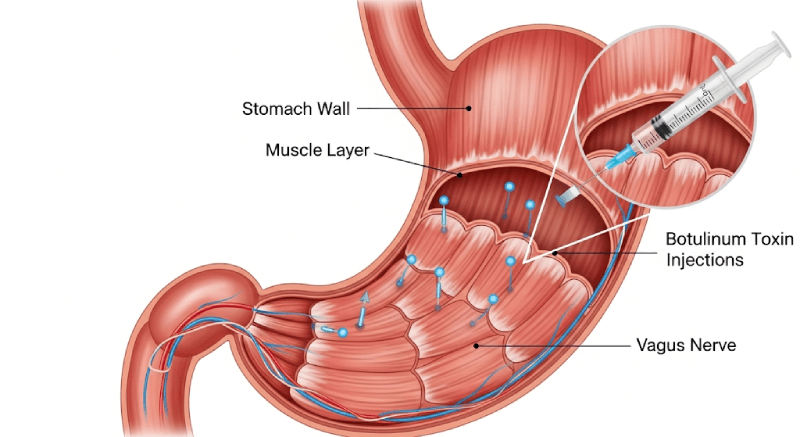
Is Stomach Botox A Permanent Solution For Obesity Treatment?
Stomach Botox is not a permanent cure for obesity itself, but it is an extremely effective supportive tool in the weight loss journey. Permanent weight loss depends on the patient maintaining new, healthy eating habits after the Botox effect wears off. If the patient uses the satiety window provided by Botox to adopt a new lifestyle, the results will be permanent. Botox serves only as an “accelerator” and “supporter”; therefore, the secret to lasting success lies in disciplined diet and lifestyle changes.
What Does The Success Rate Of Stomach Botox Depend On?
The success of stomach Botox largely depends on the patient’s degree of adherence to the diet and exercise program. Since it is a non-surgical procedure, the results obtained may not be as definitive as surgical methods, but the success rate is quite high in compliant patients. Other factors affecting success include the experience of the team performing the procedure, the accurate and sufficient dosage of Botox injected into the stomach muscles, and the quality of the Botox substance used. Especially patients who strictly follow the given nutrition rules and avoid harmful habits have a more successful weight loss journey.
Can Individuals With Chronic Diseases Get Stomach Botox?
Individuals with chronic diseases must absolutely obtain approval from their relevant specialists before undergoing stomach Botox. Risks may be involved, especially for patients with uncontrolled diabetes, serious heart and vascular diseases, clotting disorders, or neuromuscular diseases (such as Myasthenia Gravis). Diabetic patients are expected to have stable blood sugar levels. All chronic conditions and regularly used medications must be shared in detail with the gastroenterologist or plastic surgeon before the procedure. As long as the necessary precautions are taken and risks are managed, many individuals with chronic diseases can undergo stomach Botox.
What Tests Are Required Before The Procedure?
Before the stomach Botox procedure, certain standard tests are required to check the patient’s suitability for sedation and overall health status. These tests usually include complete blood count, bleeding and clotting time, liver and kidney function tests, blood sugar level, and infectious disease screenings. These tests are vital for pre-detecting any complication risk that may occur during or after sedation and ensuring patient safety. Additional tests or an ECG may be requested depending on the patient’s health history and age.
Is The Stomach Botox Procedure Performed With Endoscopy?
Yes, the stomach Botox procedure is a non-surgical procedure performed entirely using the endoscopy method. Endoscopy allows the inner surface of the stomach to be directly viewed using a flexible tube (endoscope) with a light and camera at its tip. Botox injection is performed using a very thin needle passed through the working channel of the endoscope, targeting specific points on the stomach wall, particularly the muscle groups that control appetite and gastric emptying speed. Endoscopy enables the surgeon or gastroenterologist to perform the procedure with high precision and safety.
How Is The Botox Substance Applied To The Stomach?
The Botox substance is applied to the stomach with the aid of an endoscopy device. During the procedure, a special catheter with a very fine needle at its tip is passed through the working channel of the endoscope, which is guided into the stomach. This needle is carefully inserted to reach the muscle layer (muscularis propria) of the stomach wall, which controls digestive movements and ghrelin hormone secretion. The Botox substance is injected into these strategic points, distributed evenly in small doses across numerous spots. This targeted application increases the effectiveness of the Botox while preventing it from spreading to other areas of the stomach.
Does Stomach Botox Cause Permanent Damage To The Stomach?
Stomach Botox absolutely does not cause permanent damage to the stomach. The Botulinum toxin used only temporarily reduces the contractile capacity of the stomach muscles, meaning for a duration of 4 to 6 months. At the end of this period, the effect of the toxin completely disappears, and the function and movement of the stomach muscles return entirely to normal. Since the procedure is performed endoscopically, no incision or wound occurs on the stomach surface. This temporary and reversible effect is the fundamental characteristic that makes stomach Botox a much safer and less risky option compared to surgical methods.
Which Botox Brands Are Preferred In Stomach Botox Application?
The brand of Botulinum toxin used in stomach Botox application is of great importance for the success and reliability of the procedure. Health centers in Kusadasi generally prefer high-quality, original Botox brands that are internationally recognized, FDA or European Union (CE) approved. These brands are products with proven purity and clinical efficacy. Which brand will be used in the clinic is determined in line with the patient’s request and the physician’s experience. The use of a quality brand is an important factor that directly affects the duration and reliability of the Botox effect.
Can Stomach Botox Be Repeated And When?
Yes, the stomach Botox procedure can be repeated if the patient has not reached their weight loss goal or if the effect diminishes. However, the ideal timing for repetition is when the effect of the first Botox has completely worn off and the stomach muscles have returned to normal. This period is generally determined as 6 months after the initial application. The second application helps the patient to continue supporting their weight loss. It is generally advised that stomach Botox be applied consecutively a maximum of two or three times; however, to prevent any risk of complications, the doctor’s approval should be obtained before each repetition.
Does Smoking And Alcohol Consumption Affect The Success Of The Procedure?
Smoking and alcohol consumption are significant factors that negatively affect the success of the stomach Botox procedure and overall health status. Smoking, in addition to slowing wound healing, can reduce the effectiveness of the procedure by increasing stomach acid. Alcohol, due to its high caloric content and tendency to disrupt the post-procedure diet, sabotages weight loss goals. Therefore, to maximize the effect of the Botox and relax the stomach, patients are strongly advised to strictly limit or completely stop smoking and alcohol consumption at least one week before and throughout the duration of the Botox effect (4-6 months).
When Can Sports And Exercise Be Started After Stomach Botox?
Since stomach Botox is not a surgical procedure, the recovery period is quite short, and the return to a sports routine is fast. Rest is recommended for the first 24 hours after the procedure. Patients can start non-strenuous exercises like light-paced walking 24 to 48 hours after the procedure. However, it is advisable to wait 3 to 5 days before starting heavy sports and exercises that strain the abdominal area, cause excessive sweating, or require intense effort. Regular exercise supports the weight loss provided by stomach Botox and contributes to the permanence of the results by speeding up the metabolism.
Does The Stomach Shrink After Stomach Botox Application?
Stomach Botox application does not surgically shrink the size or volume of the stomach. Botox only temporarily weakens the contractile strength of the stomach muscles, thereby slowing down the stomach’s rate of transferring digested food to the intestines (emptying time). The extended stomach emptying time gives the person a continuous feeling of fullness. If the patient makes eating regular, small portions a habit during this process, the stomach begins to feel full with less food over time. This is not surgical shrinkage but a functional slowing and adaptation.
Is There A Translator Service For Patients From Abroad?
Health tourism-focused clinics and centers in Kusadasi offer professional translation services as a standard to ensure international patients do not experience communication problems. Translators are usually individuals who speak the patient’s native language (English, German, Dutch, etc.) and are proficient in medical terminology. This service ensures the patient maintains effective communication with the physician throughout the entire process, from the initial consultation to the instructions during the procedure. Eliminating the language barrier is critically important for the patient to feel secure and to be fully informed about the procedure.
Is There An Age Limit For Stomach Botox Treatment?
In stomach Botox treatment, the lower age limit is generally expected to be over 18 years old. The upper age limit depends on the patient’s general health status and whether they have a chronic disease that prevents them from receiving sedation. Since stomach Botox is less risky than surgery, it can also be applied to elderly patients who are in good general health and have no contraindications to sedation. As with all age groups, the suitability and safety of the treatment are determined by detailed medical examination and tests performed before the procedure.
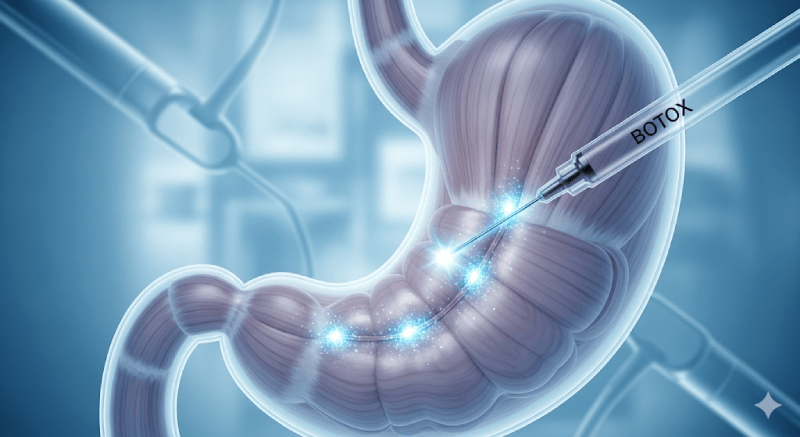
What Are The Risks Of The Stomach Botox Procedure?
Although stomach Botox is a low-risk procedure compared to surgery, potential risks exist. The rarest and most serious risk is the Botox substance spreading outside the application area, leading to systemic neuromuscular effects, but this is extremely rare. Other risks include temporary side effects related to sedation, slight bleeding at the injection site, stomach infection, or allergic reactions. However, these risks are minimized when the procedure is performed by an experienced gastroenterologist or surgeon, in a sterile environment, and using the correct dosage.
What Conditions Are Emergency Signals After The Procedure?
While the vast majority of patients recover smoothly after stomach Botox, some conditions should be considered emergency signals. These include severe, unremitting abdominal pain, uncontrollable severe nausea or vomiting lasting more than a few hours, high fever, difficulty breathing, or blood in the stool. These symptoms, though rare, can be a sign of infection, bleeding, or a severe reaction to sedation. In such a case, it is vital for the patient to immediately call the clinic in Kusadasi or the emergency service and report the situation without delay.
Is There Weight Regain After Stomach Botox?
Since the effect of stomach Botox generally wears off after 4 to 6 months, unfortunately, weight regain is possible if the patient does not change their eating habits during this period. Botox opens a window of satiety; it is the patient’s responsibility to fill this window with permanent lifestyle changes. To prevent weight regain, the portion control, slow eating habits, and regular exercise program learned while the Botox is effective must be continued after the Botox effect wears off. Long-term success is achieved through motivation and discipline.
What Is The Main Difference Between Stomach Botox And Gastric Balloon?
Stomach Botox and gastric balloon are both non-surgical weight loss methods, but their mechanisms of action are fundamentally different. Stomach Botox creates a functional feeling of fullness by slowing down the movement of the stomach muscles, and its effect wears off after 4-6 months. Gastric balloon, on the other hand, creates a volumetric feeling of fullness by physically occupying space in the stomach, and anesthesia may be required for its placement; the balloon must typically be removed endoscopically after 6 to 12 months. Botox is a less invasive, faster procedure that does not require hospitalization, while the balloon may have higher weight loss potential.
Is An Endoscopy Check Done Before The Procedure?
Yes, an endoscopy check is performed immediately before or during the stomach Botox procedure to ensure the safety of the application. This endoscopy allows for a detailed examination of the inside of the stomach. It checks for the presence of any pathological conditions that might contraindicate the Botox application, such as ulcers, gastritis (stomach inflammation), or polyps in the stomach. If such problems are detected, they must be treated first. This pre-check is a critical step to ensure both the success and the safety of the patient.
Is Dietary Support Provided In Stomach Botox Treatment?
Since the success of stomach Botox treatment largely depends on dietary compliance, competent health centers in Kusadasi generally offer support services from a specialist dietitian. This support includes analyzing the patient’s eating habits before the procedure and creating a personalized, protein-rich diet program for after the procedure. The dietitian provides follow-up and counseling not only for the first few weeks’ nutrition plan but also to teach permanent and healthy lifestyle habits that the patient can maintain after the Botox effect wears off.
Is Difficulty Swallowing Experienced After Stomach Botox?
Since stomach Botox only targets the muscles in the lower part of the stomach to reduce their contractile strength, difficulty swallowing (dysphagia) is generally not experienced. The muscles that control the swallowing function are located in the upper parts of the esophagus and throat. Botox is injected into the lower and middle parts of the stomach, not this region. Temporary difficulty in swallowing may occur in very rare cases, typically if the Botox is accidentally injected too close to the esophagus; however, this is an unexpected situation when performed by an experienced specialist.
When Can A Hot Shower Be Taken After Stomach Botox?
Since the stomach Botox procedure does not involve a surgical incision, there are no major restrictions on bathing or showering during the recovery process. Patients can take a lukewarm shower the day after the procedure once the effect of the sedation has completely worn off. However, it is advised to be cautious against the risk of dizziness in the first few hours immediately after the procedure and to avoid taking a shower with very hot water. Hot water can increase blood pressure, potentially leading to a slight feeling of discomfort. Therefore, lukewarm water should be preferred, and the patient should be carefully dried afterward.
Is The Stomach Botox Procedure Used Only For Weight Loss?
No, Botulinum toxin is not applied to the stomach only for weight loss purposes. Stomach Botox can also be used in the treatment of various stomach ailments (for therapeutic purposes). For example, in conditions where the stomach muscles are excessively active or work irregularly, such as severe gastroparesis (stomach paralysis), Botox injection can be performed to regulate and slow down muscle movements. However, the main area of use in centers in Kusadasi is generally to support patients struggling with obesity by reducing food intake and increasing the feeling of fullness.
Must The Stomach Be Empty Before The Procedure?
Yes, since the stomach Botox procedure is performed endoscopically and under sedation, it is absolutely mandatory for the patient’s stomach to be empty. Before the procedure, the patient must have stopped solid foods at least 8 hours before and liquids (including water) at least 4 hours before. Having an empty stomach is a vital safety precaution to prevent the risk of vomiting during sedation and the risk of that vomit entering the airways (aspiration). Strict adherence to these fasting and dehydration rules by the patient directly affects the safety of the procedure.
Is Gas And Bloating Experienced After Stomach Botox?
After stomach Botox, it is possible for some patients to experience temporary gas and bloating due to the slowing of the stomach’s emptying time. Since the stomach contents remain for a longer time than normal, gas accumulation and a feeling of fullness may be experienced. This condition usually resolves within a few days and can be managed with prescribed medications or supplements that aid digestion. To minimize this bloating, strict adherence to the post-procedure diet program and avoidance of gas-producing foods and beverages (beans, cabbage, carbonated drinks) are recommended.
Does Stomach Botox Have A Side Effect On The Skin?
Since Botulinum toxin is applied only regionally to the muscle layer of the stomach wall, stomach Botox does not cause any aesthetic or negative side effects on the skin. The Botox substance injected into the stomach does not affect skin wrinkles or muscles like cosmetic skin Botox. The systemic circulation rate of the toxin in the body is extremely low, and it creates a completely local effect. Therefore, patients do not need to worry about their skin health or appearance.
What Is The Follow-Up Process Like In Kusadasi After The Procedure?
Clinics in Kusadasi implement a detailed follow-up process for the safety and success of international patients. After the procedure, the patient is kept under observation for 1-2 hours, and initial nutrition instructions are given. After returning to their home country, the patient’s weight loss journey is usually continued through remote consultation (tele-consultation). Patients regularly share their weight loss, diet, and any possible difficulties they experience through the dietitian and coordinators. This regular communication and follow-up aim to keep patients motivated and reduce the risk of weight regain.
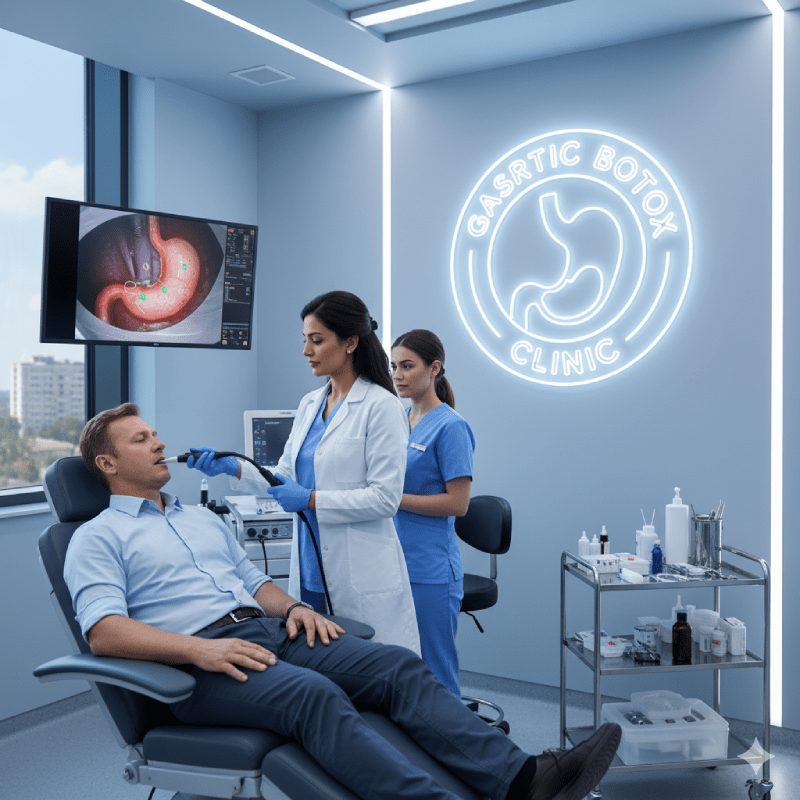
What Equipment Is Used During The Procedure?
High-tech and sterile equipment is used during the stomach Botox procedure. Essentially, a flexible and sterile videoendoscope device with a camera and light source at its tip is used. This device allows real-time viewing of the stomach. For Botox injection, a very fine and long, single-use injection needle (catheter) is passed through the endoscope’s channel. Modern anesthesia machines and monitors that track vital signs for continuous patient monitoring are used for sedation. All this equipment guarantees that the procedure is performed safely and precisely.
Does Stomach Botox Application Provide Permanent Weakness?
Stomach Botox application does not provide permanent weakness in the stomach muscles. The effect of Botulinum toxin creates a temporary blockage in the nerve-muscle connection, and the duration of this blockage is limited to 4 to 6 months. When the effect completely wears off, the muscles return to their original strength and movement. Stomach Botox offers the patient a time window and motivational support to lose weight and acquire new healthy habits through this temporary weakness and slowing. Permanent weakness is only possible with the continuity of the new lifestyle adopted by the patient during this process.
Is VAT Included In The Stomach Botox Price?
In Turkey, pricing and taxation policies for medical services offered to foreign nationals within the scope of health tourism may differ from domestic patients. Clinics in Kusadasi generally offer different quotes to international patients, with the package prices either including or excluding VAT (Value Added Tax). Therefore, when obtaining a price quote, it is important for patients to confirm in writing whether all taxes, the Botox brand, hospital costs, and supplementary services are finally included in the total fee offered. This prevents encountering unexpected additional costs.
Why Is Quitting Smoking Important Before Stomach Botox?
Quitting smoking before stomach Botox is highly important for the success of the operation and the recovery process. Nicotine in cigarettes constricts the small blood vessels in the body, especially around the stomach. This slows down the oxygenation of tissues and the healing rate. Additionally, nicotine can increase stomach acid secretion, reducing the effectiveness of stomach Botox and rarely increasing the risk of mild stomach discomfort after the procedure. Therefore, surgical teams strongly advise patients to quit this bad habit at least one week before the operation to maximize the implant’s success.
What Supplements Should Be Used After The Procedure?
After stomach Botox, some supplements are recommended to support the patient’s weight loss process healthily and prevent possible nutrient deficiencies. Dietitians usually recommend protein supplements (especially to prevent muscle loss), multivitamin and mineral supplements, and especially B vitamins, Vitamin D, and iron supplements to support hair and skin health. The use of these supplements supports healthy weight loss while ensuring the body’s basic needs are met. All supplements must be taken only upon the advice of a specialist physician or dietitian.
When Can I Travel By Plane After Stomach Botox?
Since stomach Botox is an outpatient procedure that allows for quick recovery, patients can generally travel by plane the evening of the procedure day or the day after at the latest. To ensure the effect of the sedation has completely worn off, most clinics recommend patients wait at least 6 hours after the procedure. There are no special restrictions or risks during travel. However, to prevent effects like slight dizziness due to sedation, it is recommended that the patient be well-rested and consume plenty of fluids before the flight.
Which Specialization Does The Stomach Botox Procedure Fall Under?
Since the stomach Botox procedure is an endoscopic procedure, it is generally performed by Gastroenterology specialists or General Surgery specialists who are experienced and competent in this field. The procedure’s requirement for endoscopic skill and knowledge of stomach anatomy highlights these branches. The entire process, including the patient’s stomach health (ulcer, gastritis control) and sedation management, should be carried out jointly by an expert team (gastroenterologist/surgeon and anesthesiologist). Clinics in Kusadasi generally work with certified physicians specialized in this field.
This guide of 35 detailed questions and answers provides the comprehensive overview you sought regarding Stomach Botox treatment and pricing in Kusadasi. To start your non-surgical weight loss journey with high standards and confidence, to receive personalized price quotes, and to plan your entire travel organization stress-free, we strongly recommend contacting Cure Holiday, who are experts in health tourism. They will be happy to guide you to achieve the best results.
